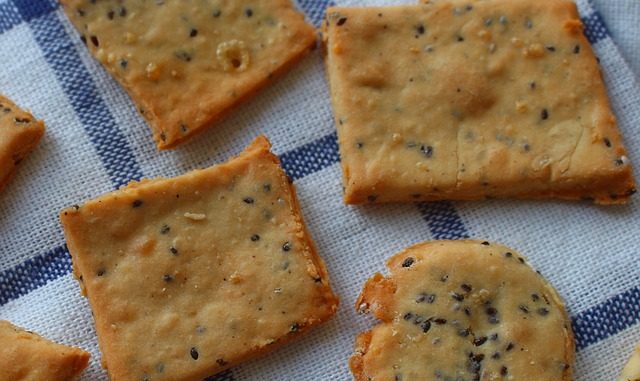
Crackers are a type of biscuit which have long been valued for their diversity and versatility. They were first produced to sustain travelers such as seafarers and sailors on their long arduous journeys. Look in any ration pack and there will most likely be a range of crackers because they are so light. Think of the travels of the intrepid heroes in ‘The Two Towers’ who are fortified by crackers made from some unmentionable flour.
All crackers by their very name are crispy, light, open textured baked biscuits which are invariably savoury. Some sweetness, or at least a perception of sweetness may be offered if a sweet vegetable or fruit is added as part of the ingredient mix. There is an almost infinite variety of types of cracker ranging from soda and snack crackers, cream crackers, water biscuits, puff biscuits, cheese biscuits, ‘Ritz’, calcium crackers, the ‘maltkist’ which is a sugar-topped cracker, saltine crackers and so on.
In more recent times, wheat flour has been removed so that a gluten-free cracker can be developed.
The key characteristics according to Davidson (2016) are:-
- Cracker doughs are leavened or fermented using either yeast, ammonia and sodium bicarbonate.
- Crackers are cut as rounds or baked as strips. In some cases they are produced as complete sheets and then broken into their individual biscuits.
- Cracker doughs have to spring or lift in the early part of the baking process which is usually in an oven. An open, flaky texture is created which requires high humidity and a good heat input to get the necessary changes.
- The traditional English cracker as it is sometimes called is baked on a light wire-mesh band.
- Traditional American crackers are baked on heavy mesh oven bands that are preheated to transfer heat rapidly by conduction through the dough pieces.
- The moisture content of a hard dough used for crackers is surprisingly high at between 15 and 30 per cent which must be reduced severely to obtain a dry biscuit. The formulations for these types of product will also have relatively small amounts of sugar and fats. It is the vigorous cutting and shearing of the dough during manufacture that develops the gluten and produces an extensible dough.
- A high energy heat input is required to generate the low moisture content in a cracker. That value is between 1.5 and 2.5%.
- The shelf-life is at least 12 months in most cases and some are designed for 3 years.
General Process Of Manufacture
- All the ingredients are mixed together in a large batch mixer. These ingredients invariably include wheat flour, water, salt, and any other flavorings or additives.
- Kneading: The dough is kneaded to develop the gluten, which gives the crackers their structure and texture.
- Resting: The cracker dough is allowed to stand to either ferment or rest for a significant period of time so that the gluten relaxes and is easier to roll out.
- Rolling: The dough is rolled out into thin sheets using a rolling pin or a machine. The thickness of the sheets can vary depending on the desired texture and crunchiness of the crackers.
- Forming: The dough is formed into various shapes, usually rounds or rectangles, but many other shapes can be generated.
- Cutting: These sheets of dough are cut into the desired shape and size using a cookie cutter or a machine.
- Baking: The crackers are baked in an oven at a high temperature until they are golden brown and crispy. The baking time and temperature may vary depending on the size and thickness of the crackers.
- Sprayed with oil or some other lubricant to allow surface coatings to be applied
- Cooling: The crackers are allowed to cool to room temperature before being packaged and shipped to stores.
- Packed and stacked typically airtight containers which preserves freshness and crispiness.
The baking of biscuits is extremely well covered in books such as:-
Biscuit Baking technology (2nd edt.) Processing and Engineering Manual (2016) by Ian Davidson
Baking problems Solved (2nd edt.) Woodhead Publ. Series in Food Science, Technol., Nutr.
The range of books by Duncan Manley cover every aspect of biscuit manufacture and remain the Gold Standard in terms of advice on biscuit manufacturing generally.
Nutritional Value
Crackers contain an extraordinary range of flours and lend themselves to addition of minerals and vitamins (Asp, 2004). Many are used as vehicles for iron fortification. The whole-wheat and rye crackers have very high mineral contents. A rye wafer is noted for its potassium, iron, copper, zinc and magnesium content. A whole-wheat cracker which is a cheese-filled sandwich can offer calcium, sodium and phosphorous.
The weakest in terms of mineral content are whole-wheat crackers which are poor in sodium, phosphorous and potassium hence the addition of the cheese filling. Rye wafers are low in calcium
Soda Crackers
In the USA, soda crackers(saltines or premium crackers) are preferred by those who do not have time for cream crackers. They are square and tend to be much smaller than cream crackers (Manley, 2001). These are made by the sponge and dough technique. The critical feature is the use of sodium bicarbonate which raises the pH and makes them higher than a cream cracker. The name ‘soda’ has stuck as a result.
Soda crackers are typically 4 mm thick and 50 × 50 mm square. The shortening content is 8–10%.
References
Asp, E. (2004) Nutrition: Mineral Composition. In: Encyclopedia of Grain Science. pp. 340-348 https://doi.org/10.1016/B0-12-765490-9/00099-9
Cauvain, S.P. (2016) Cookies, Biscuits and Crackers: Formulation, processing and Characteristics. References Module in Food Science. https://doi.org/10.1016/B978-0-08-100596-5.00119-0
Cauvain, S.P. (2017) Chapter 6 – Biscuits, Cookies, Crackers and Wafers. In: Baking Problems Solved (2nd edt.) pp. 299-329 https://doi.org/10.1016/B978-0-08-100765-5.00006-0
Davidson, I. (2016) Chapter 1- The Biscuits. In: Biscuit Baking Technology (2nd edt.) Processing and Engineering Manual. pp. 1-34 https://doi.org/10.1016/B978-0-12-804211-3.00001-7
Manley, D. (2001) Recipes for hard doughs. In: Biscuit, Cracker and Cookie recipes for the Food Industry. Elsevier.
Leave a Reply